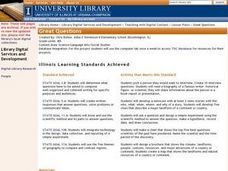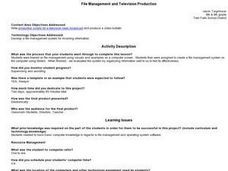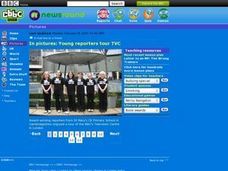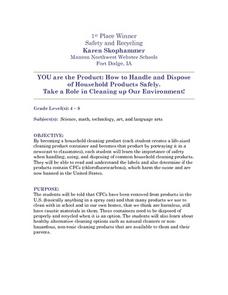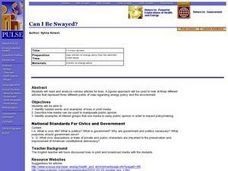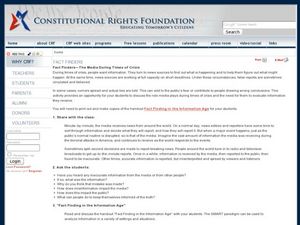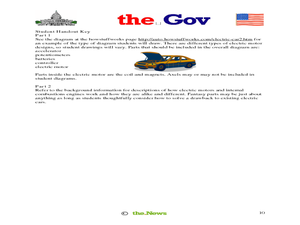Curated OER
What is News?
Eighth graders discover elements that make a story newsworthy. They play an online game about newsworthy stories and complete a worksheet with partners. They also examine the difference between facts and opinions.
Curated OER
2, 4, 6, 8 . . .What Do We Appreciate-Patterns, Patterns, Patterns
Young scholars discover and predict patterns in a numerical sequence. Through the Internet and video segments, students begin with basic number patterns and extend their knowledge into higher math skills. They will also create new...
Curated OER
Check Out Lights and Shields with Beads
Students explore Ultraviolet detecting beads and conduct several investigations with them. For this investigative lesson students participate in an experiment to see the harmful effects of UV light and discuss their findings.
Curated OER
Draw, Pardner!
Students explore how to draw in 3-D. In this visual arts lesson, students use newsprint and a yard stick to construct three dimensional drawings of objects.
Curated OER
Taking a Stand: Pros and Cons of Forest Fires
Students explore the pros and cons of forest fires. In this science lesson, students research the ecological implications of forest fires. Students record their findings in journals and compose a persuasive e-mail to government officials.
Curated OER
New Deal Agencies
Students identify examples of government intervention during crisis. In this New Deal lesson, students play a game to place descriptions and names to abbreviations of New Deal Agencies. Students interview a person who lived through the...
Curated OER
Where journalism meets art
Students pick out the different techniques in photographs taken. In this photographs lesson plan, students critique patterns, shadows, reflections, and more in the photographs.
Curated OER
The Electric Experience
Students investigate the effects of television and radio on culture. In this journalism lesson, students consider how electronic media has shaped journalism as they create timelines that feature the changes and compare and contrast print...
Curated OER
Looking Back, Up and Ahead
Students explore how scientists have forecasted the 2002 Leonid meteor shower. They pose their own predictions for peak meteor rates per hour during the 2002 shower and compare their results with actual observed rates.
Curated OER
Tracking Olympic Gold!
Students use print or online resources to track the results of the Olympic Games, record daily results on graphs, use graphs to collect information.
Curated OER
Working on the Railroad
Pupils view and discuss "The Transportation Revolution," a lecture by Peter A. Coclanis. They read and respond creatively to brief descriptions of railroad workers and their job responsibilities.
Curated OER
Promoting Fluency and Accuracy Through Planning, Telling, Transcribing and Noticing
Students promote fluency through planning and noticing language through transcribing and correcting recorded anecdotes. They provide opportunities for long turns in speaking and give intensive listening practice.
Curated OER
Casting a Wide Net
Students investigate topics that would be suitable for classroom podcasts. They read an online article, write and produce a podcast.
Curated OER
Great Questions
Fourth graders research and create questions about a famous person. They create questions in a game format, create a computer generated brochure, and develop rubrics for their finished projects.
Curated OER
File Management and Television Production
Young scholars create file management systems, and produce video bulletins.
Curated OER
In pictures: Young reporters tour TVC
Students view a wide range of young reporters and their accomplishments. They view all the places they toured and then analyze one particular place in pictures. Students create a portfolio out of their pictures for view.
Curated OER
I Want To Take A Picture In 1866!
Eighth graders examine the role of technology. In the Civil War lesson, 8th graders look at the advent of photography and determine the impact of photography on the Civil War.
Curated OER
How to Handle and Dispose of Household Products Safely
Students engage in the study of household cleaning products, how to read the labels and how to use them safely and also how to properly dispose of the containers when they are empty. They read the labels and determine if the products...
Curated OER
Can I Be Swayed?
Students identify loaded words and examples of bias in print media. They describe how media can be used to manipulate public opinion. Students identify examples of interest groups that use media to sway public opinion in order to impact...
Curated OER
Confronting Genocide
Students discover what the term genocide means and are assigned to groups to reasearch an act of genocide in order to answer each question from their worksheet. They then compare their results making special notes of patterns they observe.
Curated OER
Fact Finders—The Media During Times of Crisis
Learners practice finding reputable facts. In this media awareness lesson, students review a handout regarding tips for evaluating media and then discover the SMART method which they use to analyze news sources and media.
Curated OER
War and the Media Fact Finders: The Media in Times of Crisis
Pupils explore the role of the media in war reporting. In this information age lesson, students discuss how to find and disseminate factual information. Pupils consider the source, motive, authority of information.
Curated OER
El Niño and it's Impact on the World
Students explore the causes of El Niño. In this series of earth science lesson, students research the consequences of this weather phenomenon. They recommend ways to prepare for this disaster.
Curated OER
Electric Car: American Industry and Innovation
Students study how an electric car operates. In this electric car instructional activity students assemble an electric car motor from parts from an internal combustion engine.















